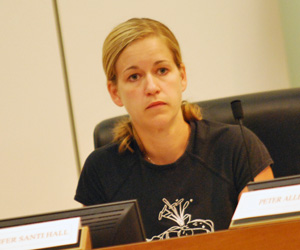Greenbelt Group Briefed on Bioreserve
Ann Arbor greenbelt advisory commission meeting (Feb. 6, 2014): Kris Olsson, an ecologist with the Huron River Watershed Council, was on hand at GAC’s meeting to provide commissioners with an overview of the HRWC’s bioreserve project.

Kris Olsson, a watershed ecologist with the Huron River Watershed Council, at the Feb. 6, 2014 meeting of the Ann Arbor greenbelt advisory commission. (Photos by the writer.)
The aim of the project is to map, prioritize and encourage protection of the remaining natural areas in the Huron River watershed. The entire watershed covers about 994,000 acres. Of that about 247,000 acres are in the bioreserve. More than 1,700 sites have been mapped as potential natural areas.
The Ann Arbor greenbelt program is one of several partners in the project. Olsson told commissioners that the HRWC hopes this data is used to help land preservation programs like the greenbelt make informed decisions about how to protect natural areas.
Also during the Feb. 6 meeting, Ginny Trocchio – who provides staff support for the greenbelt program – briefed commissioners on the screening and scoring criteria used to review potential acquisitions for the greenbelt program. She reviewed characteristics that result in higher scores for property. For example, sites that receive higher scores have 3-4 natural features (stream corridors, woodlots or rare species), are located within 1 mile of the Ann Arbor city limits, and are located within a township or village that has passed a purchase-of-development-rights (PDR) ordinance.
Trocchio also reported that work on the greenbelt program’s new landowner registry is continuing.
The 90-minute meeting included a closed session lasting about 30 minutes. No votes were taken on potential land deals after commissioners emerged from closed session. [Full Story]




